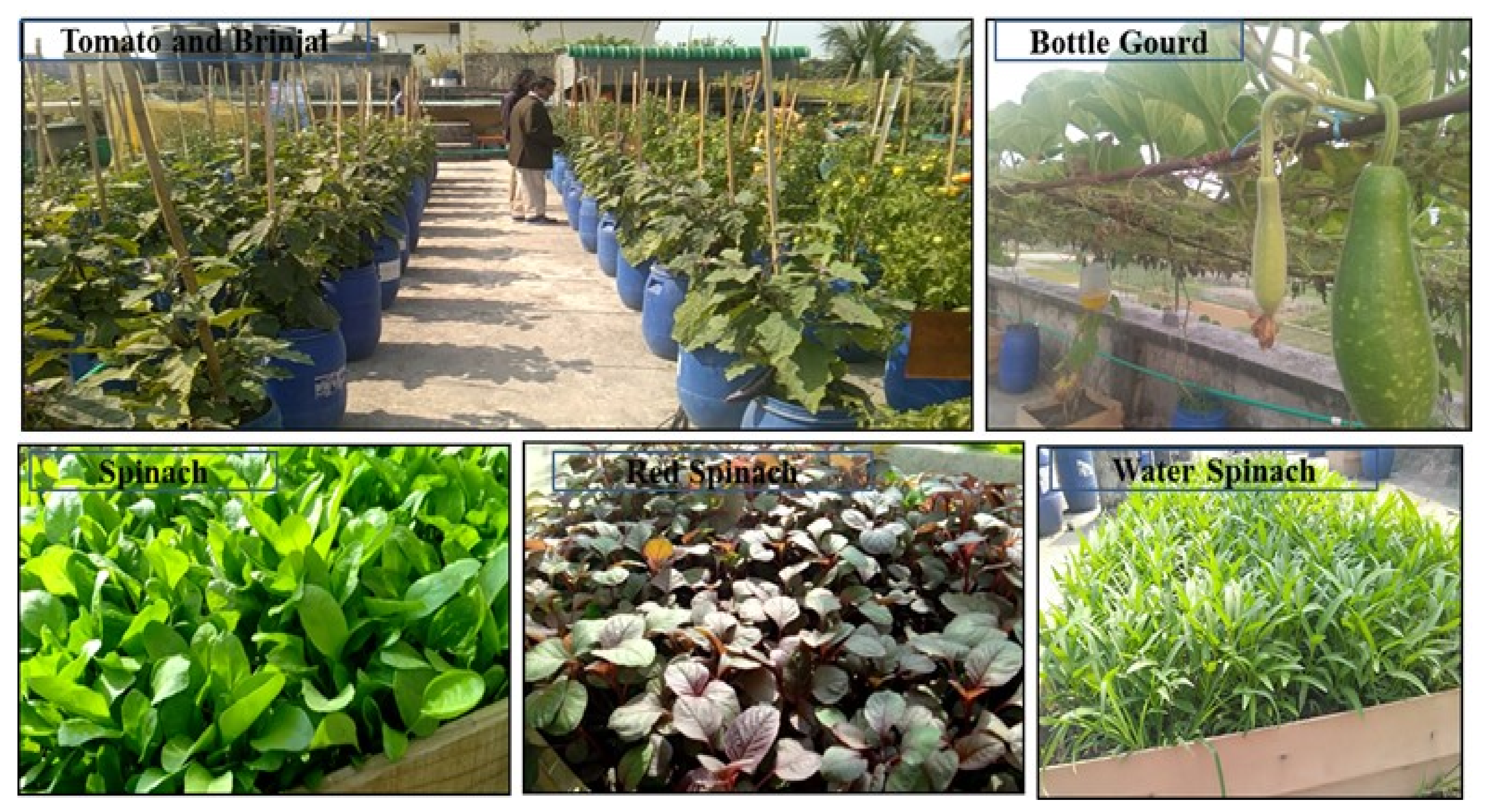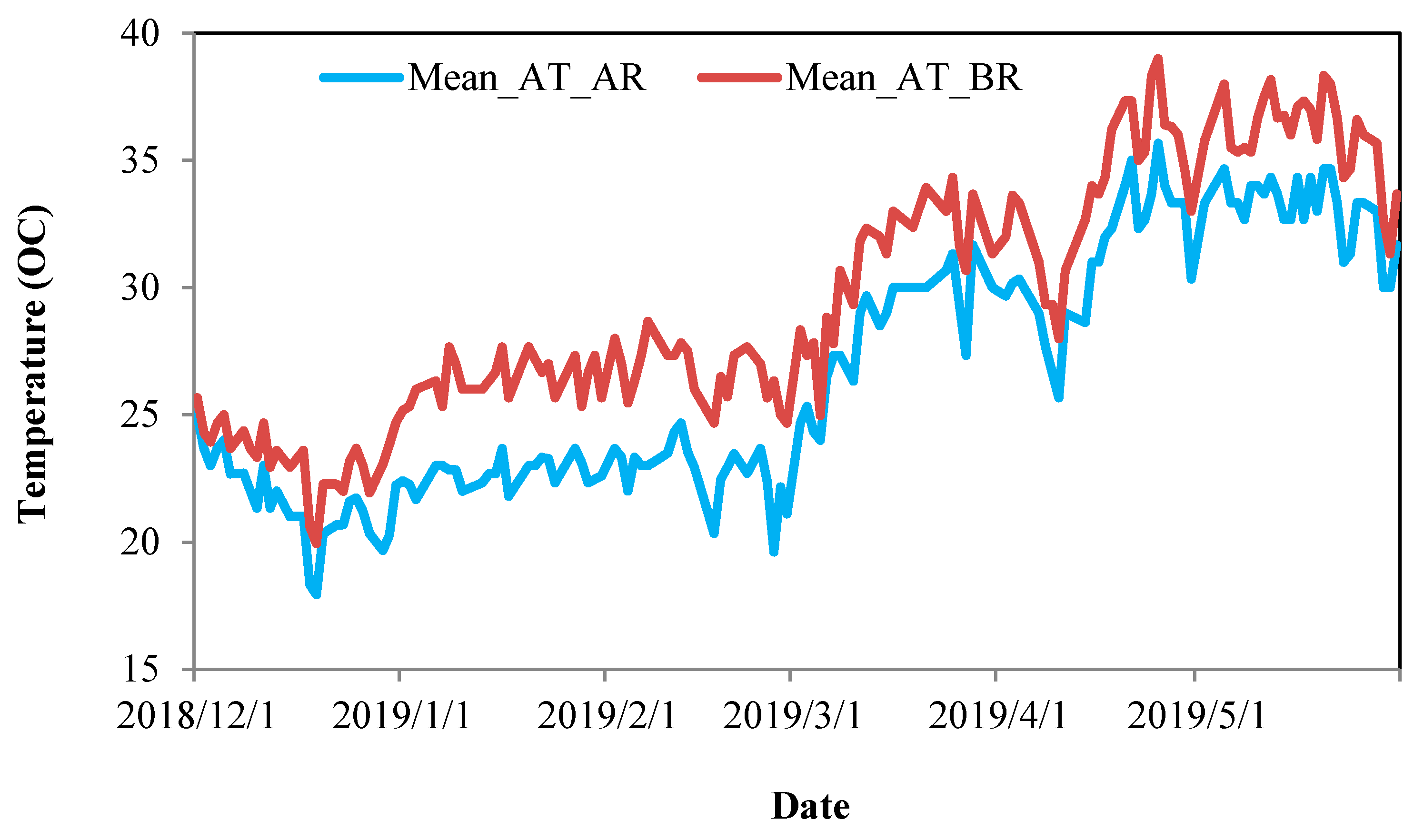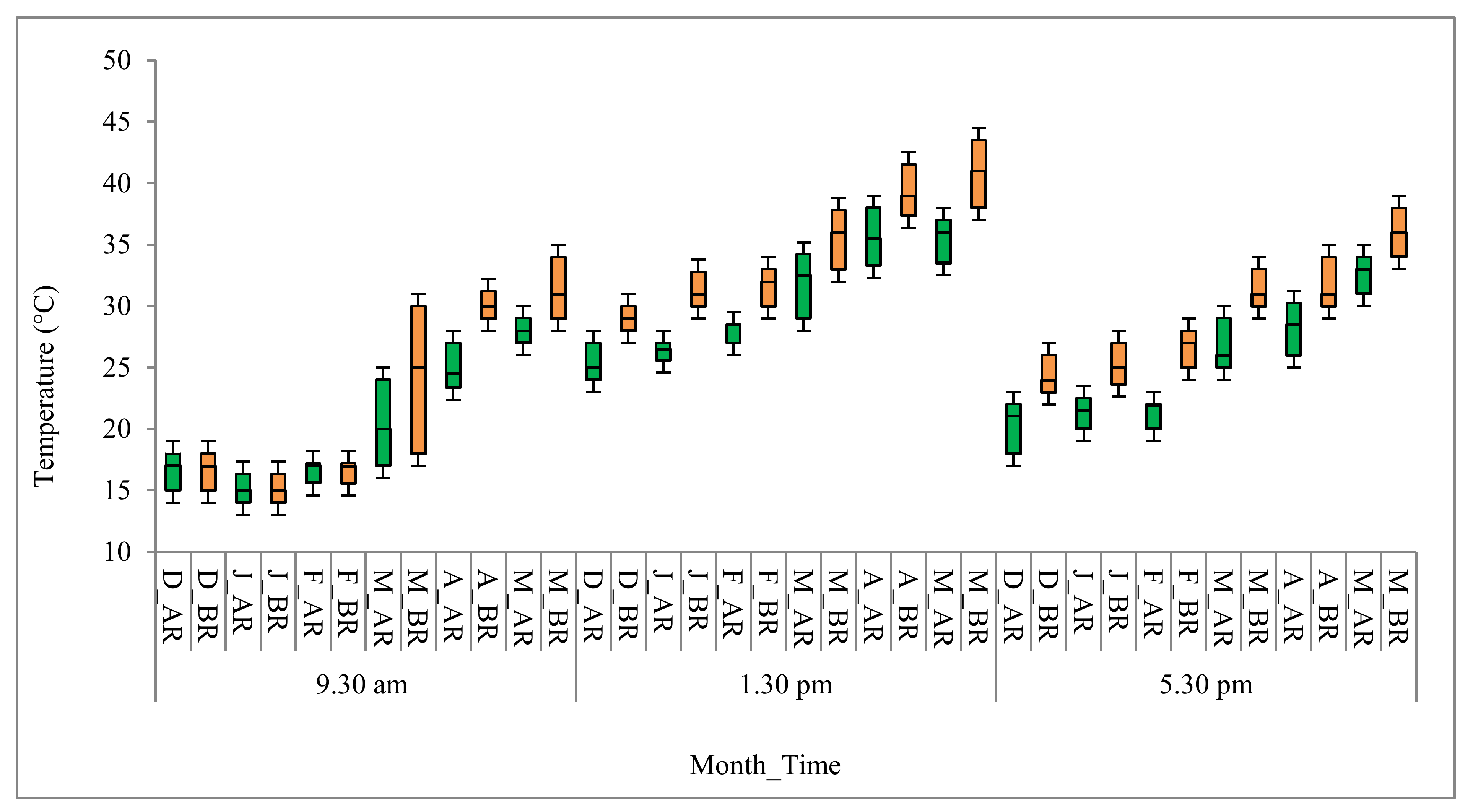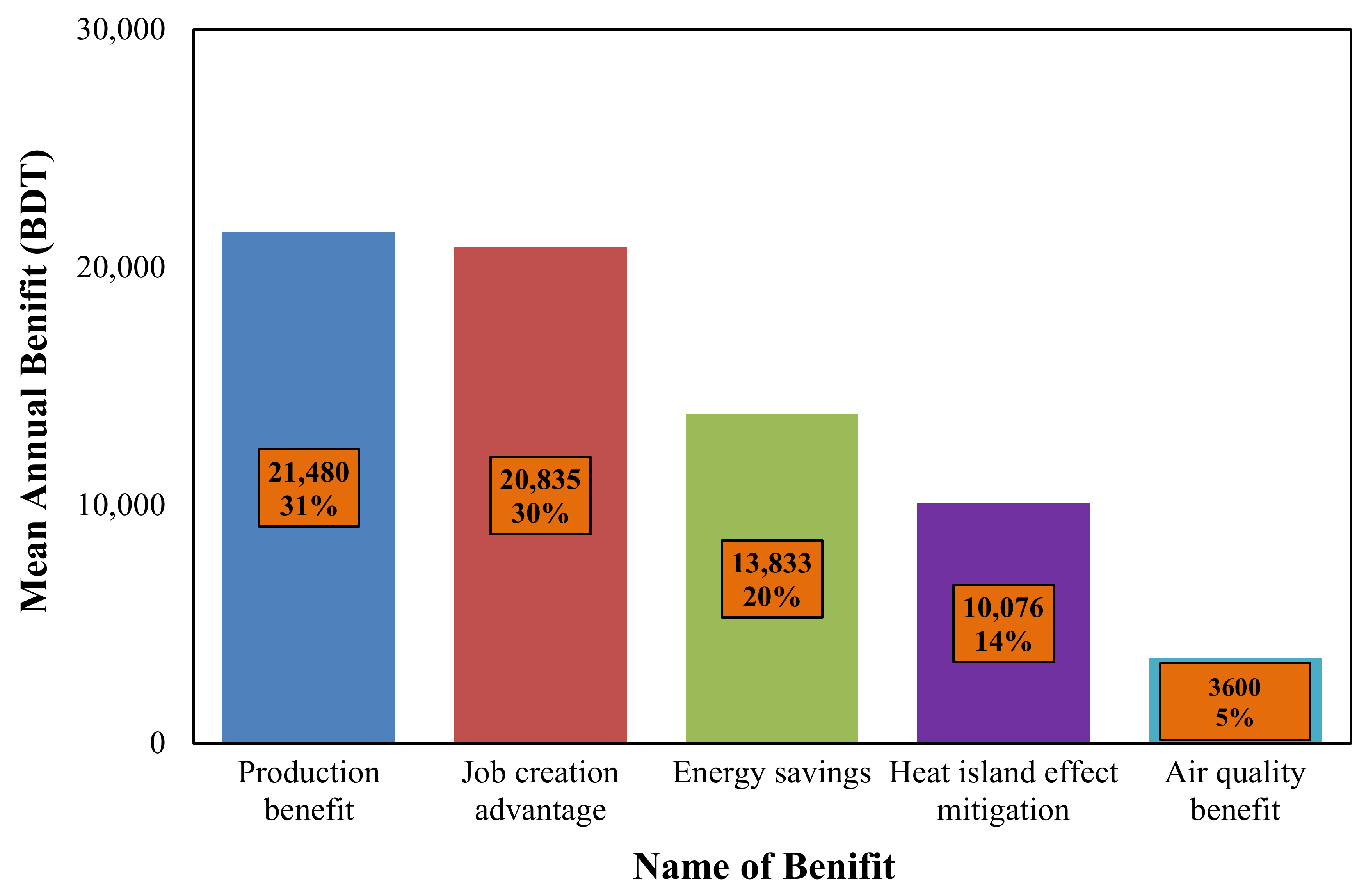Environmental and Social Dynamics of Urban Rooftop Agriculture (URTA) and Their Impacts on Microclimate Change
Abstract
:1. Introduction
2. Materials and Methods
2.1. Study Area and Research Design
2.2. Methodology
2.2.1. Temperature, Relative Humidity (RH) and Carbon Dioxide (CO2) Concentration Measurements
2.2.2. Temperature Trend Measurement of Soil in the Container and Air under URTA
2.2.3. Cooling Degree Day (CDD) Calculation
2.2.4. Overall Heat Transfer Coefficient Calculation
2.2.5. Cooling Load and Energy Saving Calculation
2.2.6. Analysis of Yield and Commercial Value of Selected Crops in the URTA
2.2.7. Economic Analysis of URTA
- Ft = net cash inflow-outflows during a single period;
- r = discount rate or return that be earned in alternative investments;
- Ci = initial investment cost of all setups of URTA;
- t = number of years within the time periods of first instalment of URTA, generally computed yearly for which the economic evaluation is desired (15 years for this study).
| Variable | Value | Source |
|---|---|---|
| The installation cost of URTA system including (i) installation of irrigation system and fencing panels, (ii) containers and other concrete structures, (iii) electrical equipment (light, fan, Wi-Fi connection) soil, conduct, varmicompost and equipment needed) | BDT 1460 per square meter | Local practitioners |
| Annual operations and maintenance cost | BDT 120 per square meter for 150 m | Local practitioners of Bangladesh |
| Annual irrigation cost (source: Groundwater) | BDT 8.7/m2 and BDT 15.7/m2 for vertical agriculture | Dhaka Water Supply and Sewerage Authority (DWASA), Bangladesh |
| Annual irrigation cost (source: Rainwater and grey water) | --- | --- |
| Total cost for the starting year | --- | --- |
| Annual fresh food production benefit (summer and winter season, shown in table) | BDT 138.90/m2 | Local practitioners of Bangladesh |
| Annual Energy consumption benefit | BDT 184.45/m2 | Local practitioners of Dhaka Power Distribution Company Ltd. (DPDC) in Bangladesh energy consumption tariff |
| AR-enhanced air quality advantage | BDT 2/m2 | [41,50] |
| Job creation advantage | BDT 138.90/m2 | Local practitioners of Bangladesh |
| Mitigation of heat island effect | BDT 67.17/m2 | [51,52] |
3. Result and Discussion
3.1. Environmental Dynamics of Urban Rooftop Agriculture (URTA)
3.1.1. Thermal Dynamics of URTA
3.1.2. Near Roof Surface Thermal Dynamics in AR and BR
3.1.3. Air Temper Inclines in AR Relative to Distance from Roof Surface
3.1.4. Relative Humidity Dynamics of AR and BRs
3.1.5. CO2 Dynamics for the AR and BR
3.1.6. CDD and Cooling Load Potential Dynamics of Different Type of URTA
3.1.7. Energy Savings Dynamics of Different Type of URTA
3.2. Socio-Economic Analysis
3.2.1. Gender-Sensitive Socialization of URTA
3.2.2. Economic Dynamics of URTA
4. Conclusions
Author Contributions
Funding
Institutional Review Board Statement
Informed Consent Statement
Data Availability Statement
Acknowledgments
Conflicts of Interest
References
- Fonseka, H.P.U.; Zhang, H.; Sun, Y.; Su, H.; Lin, H.; Lin, Y. Urbanization and Its Impacts on Land Surface Temperature in Colombo Metropolitan Area, Sri Lanka, from 1988 to 2016. Remote Sens. 2019, 11, 957. [Google Scholar] [CrossRef] [Green Version]
- Saini, V.; Tiwari, R.K. Effect of Urbanization on Land Surface Temperature and NDVI: A case study of Dehradun, India. In Proceedings of the 38th Asian Conference on Remote Sensing, New Delhi, India, 23–27 October 2017. [Google Scholar]
- Wong, N.H.; Cheong, D.K.W.; Yan, H.; Soh, J.; Ong, C.L.; Sia, A. The effects of rooftop garden on energy consumption of a commercial building in Singapore. Energy Build. 2003, 35, 353–364. [Google Scholar] [CrossRef]
- Nadal, A.; Llorach-Massana, P.; Cuerva, E.; López-Capel, E.; Montero, J.I.; Josa, A.; Rieradevall, J.; Royapoor, M. Building-Integrated Rooftop Greenhouses: An Energy and Environmental Assessment in the Mediterranean Context. Appl. Energy 2017, 187, 338–351. [Google Scholar] [CrossRef] [Green Version]
- Elmes, A.; Rogan, J.; Williams, C.; Ratick, S.; Nowak, D.; Martin, D. Effects of Urban Tree Canopy Loss on Land Surface Temperature Magnitude and Timing. ISPRS J. Photogramm. Remote Sens. 2017, 128, 338–353. [Google Scholar] [CrossRef]
- Barreca, F. Rooftop Gardening. A Solution for Energy Saving and Landscape Enhancement in Mediterranean Urban Areas. Procedia Soc. Behav. Sci. 2016, 223, 720–725. [Google Scholar] [CrossRef] [Green Version]
- Kasera, S.; Nayyar, A.; Sharma, D. The Energy Consumption Performance of Roof Garden. Int. J. Sci. Eng. Res. 2012, 3, 470–473. [Google Scholar]
- Ascione, F.; Bianco, N.; de’ Rossi, F.; Turni, G.; Vanoli, G.P. Green Roofs in European Climates. Are Effective Solutions for the Energy Savings in Air-Conditioning? Appl. Energy 2013, 104, 845–859. [Google Scholar] [CrossRef]
- Zinzi, M.; Agnoli, S. Cool and Green Roofs. An Energy and Comfort Comparison between Passive Cooling and Mitigation Urban Heat Island Techniques for Residential Buildings in the Mediterranean Region. Energy Build. 2012, 55, 66–76. [Google Scholar] [CrossRef]
- Sookchaiya, T.; Monyakul, V.; Thepa, S. Assessment of the Thermal Environment Effects on Human Comfort and Health for the Development of Novel Air Conditioning System in Tropical Regions. Energy Build. 2010, 42, 1692–1702. [Google Scholar] [CrossRef]
- Li, Y.; Pizer, W.A.; Wu, L. Climate Change and Residential Electricity Consumption in the Yangtze River Delta, China. Proc. Natl. Acad. Sci. USA 2019, 116, 472–477. [Google Scholar] [CrossRef] [Green Version]
- Bryan, E.; Ringler, C.; Okoba, B.; Koo, J.; Herrero, M.; Silvestri, S. Agricultural Management for Climate Change Adaptation, Greenhouse Gas Mitigation, and Agricultural Productivity; Discuss. Pap.: No. 01098; IFPRI: Washington, DC, USA, 2011. [Google Scholar]
- Yasumoto, S.; Jones, A.P.; Oyoshi, K.; Kanasugi, H.; Sekimoto, Y.; Shibasaki, R.; Comber, A.; Watanabe, C. Heat Exposure Assessment Based on Individual Daily Mobility Patterns in Dhaka, Bangladesh. Comput. Environ. Urban Syst. 2019, 77, 101367. [Google Scholar] [CrossRef]
- Barozzi, B.; Bellazzi, A.; Maffè, C.; Pollastro, M.C. Measurement of Thermal Properties of Growing Media for Green Roofs: Assessment of a Laboratory Procedure and Experimental Results. Buildings 2017, 7, 99. [Google Scholar] [CrossRef] [Green Version]
- Muthamilselvan, A.; Srimadhi, K.; Ramalingam, N.; Pavithra, P. Urbanization and Its Related Environmental Problem in Srirangam Island, Tiruchirappalli District of Tamil Nadu, India-Thermal Remote Sensing and GIS Approach. Environ. Earth Sci. 2016, 75, 765. [Google Scholar] [CrossRef]
- Alavipanah, S.; Wegmann, M.; Qureshi, S.; Weng, Q.; Koellner, T. The Role of Vegetation in Mitigating Urban Land Surface Temperatures: A Case Study of Munich, Germany during the Warm Season. Sustainability 2015, 7, 4689–4706. [Google Scholar] [CrossRef] [Green Version]
- Benis, K.; Reinhart, C.; Ferrão, P. Development of a Simulation-Based Decision Support Workflow for the Implementation of Building-Integrated Agriculture (BIA) in Urban Contexts. J. Clean. Prod. 2017, 147, 589–602. [Google Scholar] [CrossRef]
- Xu, M.; Hong, B.; Jiang, R.; An, L.; Zhang, T. Outdoor Thermal Comfort of Shaded Spaces in an Urban Park in the Cold Region of China. Build. Environ. 2019, 155, 408–420. [Google Scholar] [CrossRef]
- Cascone, S.; Catania, F.; Gagliano, A.; Sciuto, G. A Comprehensive Study on Green Roof Performance for Retrofitting Existing Buildings. Build. Environ. 2018, 136, 227–239. [Google Scholar] [CrossRef]
- Zinia, N.J.; McShane, P. Ecosystem Services Management: An Evaluation of Green Adaptations for Urban Development in Dhaka, Bangladesh. Landsc. Urban Plan. 2018, 173, 23–32. [Google Scholar] [CrossRef]
- Castleton, H.F.; Stovin, V.; Beck, S.B.M.; Davison, J.B. Green Roofs; Building Energy Savings and the Potential for Retrofit. Energy Build. 2010, 42, 1582–1591. [Google Scholar] [CrossRef]
- Moulai, M.; Kharvari, F.; Shahhosseini, G.; Zanjani, N.E. A Study of the Urban Heat Island Mitigation Strategies: The Case of Two Cities. Int. J. Urban Manag. Energy Sustain. 2017, 1, 1–7. [Google Scholar]
- Mainuddin, M.; Kirby, M. National food security in Bangladesh to 2050. Food Secur. 2015, 7, 633–646. [Google Scholar] [CrossRef]
- Corburn, J. Cities, Climate Change, and Urban Heat Island Mitigation: Localizing Global Environmental Science. Urban Stud. 2009, 46, 413–427. [Google Scholar] [CrossRef]
- Specht, K.; Siebert, R.; Thomaier, S. Perception, and Acceptance of Agricultural Production in and on Urban Buildings (ZFarming): A Qualitative Study from Berlin, Germany. Agric. Hum. Values 2016, 33, 753–769. [Google Scholar] [CrossRef]
- Berardi, U.; Ghaffarian, H.A. State of the art analysis of the environmental benefits of green roofs. Int. J. Appl. Energy 2014, 115, 411–428. [Google Scholar] [CrossRef]
- Alhashimi, L.; Aljawi, L.; Asghar, R.; Alamoudi, A. The effect of rooftop garden on reducing the internal temperature of the rooms in buildings. In Proceedings of the 4th World Congress on Mechanical, Chemical, and Material Engineering, Madrid, Spain, 16–18 August 2018. Paper No. ICMIE114. [Google Scholar]
- Martin, G.; Clift, R.; Christie, I. Urban cultivation and its contributions to sustainability: Nibbles of food but oodles of social capital. Int. J. Sustain. 2016, 8, 409. [Google Scholar] [CrossRef] [Green Version]
- Vijayaraghavan, K. Green Roofs: A Critical Review on the Role of Components, Benefits, Limitations and Trends. Renew. Sustain. Energy Rev. 2016, 57, 740–752. [Google Scholar] [CrossRef]
- Badami, M.G.; Ramankutty, N. Urban agriculture and food security: A critique based on an assessment of urban land constraints. Glob. Food Secur. 2015, 4, 8–15. [Google Scholar] [CrossRef]
- Safayet, M.; Arefin, M.F.; Hasan, M.M.U. Present practice and future prospect of rooftop farming in Dhaka city: A step towards urban sustainability. Int. J. Urban Manag. 2017, 6, 56–65. [Google Scholar] [CrossRef]
- Jones, H.; Domingos, T.; Moura, F.; Sussman, J. Transport Infrastructure Evaluation Using Cost-Benefit Analysis: Improvements to Valuing the Asset through Residual Value—A Case Study. In Proceedings of the Transportation Research Board (TRB) 93rd Annual Meeting, Washington, DC, USA, 12–16 January 2014; pp. 1–17. [Google Scholar]
- Nadal, A.; Rodríguez-Cadena, D.; Pons, O.; Cuerva, E.; Josa, A.; Rieradevall, J. Feasibility Assessment of Rooftop Greenhouses in Latin America. The Case Study of a Social Neighborhood in Quito, Ecuador. Urban For. Urban Green. 2019, 44, 126389. [Google Scholar] [CrossRef]
- Cohen, P.; Shashua-Bar, L.; Keller, R.; Gil-Ad, R.; Yaakov, Y.; Lukyanov, V.; Bar, P.; Tanny, J.; Cohen, S.; Potchter, O. Urban Outdoor Thermal Perception in Hot Arid Beer Sheva, Israel: Methodological and Gender Aspects. Build. Environ. 2019, 160, 106169. [Google Scholar] [CrossRef]
- Department of Economic and Social Affairs, Population Division. World Urbanization Prospects: The 2014 Revisions; United Nations: New York, NY, USA, 2015; p. 27. [Google Scholar]
- Kaloustian, N.; Bitar, H.; Diab, Y. Urban heat island and urban planning in Beirut. In Proceedings of the 4th International Conference on Countermeasures to Urban Heat Island, Singapore, 30 May–1 June 2016. [Google Scholar]
- Ishtiaque, A.T.; Tasin, T.Z.; Akter, K.S. Urban Heat Island Intensity Assessment through comparative study on land surface temperature and normalized difference vegetation index: A Case Study of Chittagong. Int. J. Urban Civ. Eng. 2017, 11, 37–42. [Google Scholar]
- Raji, B.; Tenpierik, M.J.; Dobbelsteen, A. The impact of greening systems on building energy performance: A literature review. Renew. Sustain. Energy Rev. 2015, 45, 610–623. [Google Scholar] [CrossRef] [Green Version]
- Islam, M.; Al Nayeem, A.; Majumder, A.K.; Tanjim Elahi, K. Study on the Status of Roof Top Gardening in Selected Residential Areas of Dhaka City, Bangladesh. Malays. J. Sustain. Agric. 2019, 3, 31–34. [Google Scholar] [CrossRef]
- Heady, H.F. The Measurement and Value of Plant Height in the Study of Herbaceous Vegetation. Ecol. Soc. Am. 1957, 38, 313–320. [Google Scholar] [CrossRef] [Green Version]
- Kim, E.; Jung, J.; Hapsari, G.; Kang, S.; Kim, K.; Yoon, S.; Lee, M.; Han, M.; Choi, Y.; Choe, J.K. Economic and Environmental Sustainability and Public Perceptions of Rooftop Farm versus Extensive Garden. Build. Environ. 2018, 146, 206–215. [Google Scholar] [CrossRef]
- Jafari, N.; MohdYunos, M.Y.; Mydin, M.A.O.; Mohd Tahir, O. Assessing the Residents’ Preference of Awareness Regarding Urban Agriculture at Rooftop Garden. Appl. Mech. Mater. 2015, 747, 180–183. [Google Scholar] [CrossRef]
- Sabeh, N. Rooftop Plant Production Systems in Urban Areas. Plant Factory: An Indoor Vertical Farming System for Efficient Quality Food Production; Academic Press: Cambridge, MA, USA, 2015. [Google Scholar]
- Pandey, S.; Hindoliya, D.A.; Mod, R. Experimental investigation on green roofs over buildings. Int. J. Low Carb. Technol. 2013, 8, 37–42. [Google Scholar] [CrossRef] [Green Version]
- Schroeder, C. Thermal Conductivity of Building Materials. Sci. Am. 1921, 3, 243–244. [Google Scholar] [CrossRef]
- Krese, G.; Prek, M.; Butala, V. Analysis of Building Electric Energy Consumption Data Using an Improved Cooling Degree Day Method. Stroj. Vestn. J. Mech. Eng. 2012, 58, 107–114. [Google Scholar] [CrossRef]
- La Roche, P.; Berardi, U. Comfort and Energy Savings with Active Green Roofs. Energy Build. 2014, 82, 492–504. [Google Scholar] [CrossRef]
- Liu, K. Energy Efficiency and Environmental Benefits of Rooftop Gardens. Constr. Canada 2002, 44, 20–23. [Google Scholar]
- Au, T.; Au, T.P. Engineering Economics for Capital Investment Analysis; Allyn and Bacon: Newton, MA, USA, 1983. [Google Scholar]
- Jafari, N.; Utaberta, N.; Yunos, M.Y.M.; Ismail, N.A.; Ismail, S.; Ariffin, N.F.M.; Jafari, N.; Valikhani, M. Benefits of Roof Garden in Order to Usage of Urban Agriculture at Roof Garden in High-Rise Building in Malaysia. Adv. Environ. Biol. 2015, 9, 86–92. [Google Scholar]
- Francis, L.F.M.; Jensen, M.B. Benefits of Green Roofs: A Systematic Review of the Evidence for Three Ecosystem Services. Urban For. Urban Green. 2017, 28, 167–176. [Google Scholar] [CrossRef]
- Berardi, U. The Outdoor Microclimate Benefits and Energy Saving Resulting from Green Roofs Retrofits. Energy Build. 2016, 121, 217–229. [Google Scholar] [CrossRef]
- Morakinyo, T.E.; Kalani, K.W.D.; Dahanayake, C.; Ng, E.; Chow, C.L. Temperature and cooling demand reduction by green-roof types in different climates and urban densities: A co-simulation parametric study. Energy Build. 2017, 145, 226–237. [Google Scholar] [CrossRef]
- Cai, L.; Feng, X.P.; Yu, J.Y.; Xiang, Q.C.; Chen, R. Reduction in carbon dioxide emission and energy savings obtained by using a green roof. Aerosol Air Qual. Res. 2019, 19, 2432–2445. [Google Scholar] [CrossRef]
- Alexandri, E.; Jones, P. Temperature decreases in an urban canyon due to green walls and green roofs in diverse climates. Build. Environ. 2008, 43, 480–493. [Google Scholar] [CrossRef]
- Mahmoodzadeh, M.; Mukhopadhyaya, P.; Valeo, C. Effects of Extensive Green Roofs on Energy Performance of School Buildings in Four North American Climates. Water 2020, 12, 6. [Google Scholar] [CrossRef] [Green Version]
- Silva, C.M.; Gomes, M.G.; Silva, M. Green roofs energy performance in Mediterranean climate. Energy Build. 2016, 116, 318–325. [Google Scholar] [CrossRef]
- Mahmoud, A.S.; Asif, M.; Hassanain, M.A.; Babsail, M.O.; Sanni-Anibire, M.O. Energy and economic evaluation of green roofs for residential buildings in hot-humid climates. Buildings 2017, 7, 30. [Google Scholar] [CrossRef]
- Wang, T.; Pryor, M. Social Value of Urban Rooftop Farming: A Hong Kong Case Study. Agric. Econ. Curr. Issues 2019. [Google Scholar] [CrossRef] [Green Version]
- Anand, C.; Apul, D.S. Economic and environmental analysis of standard, high efficiency, rainwater flushed, and composting toilets. J. Environ. Manag. 2011, 92, 419–428. [Google Scholar] [CrossRef] [PubMed]
- Pulighe, G.; Lupia, F. Multitemporal geospatial evaluation of urban agriculture and (non)-sustainable food self-provisioning in Milan, Italy. Sustainability 2019, 11, 1846. [Google Scholar] [CrossRef] [Green Version]













| Particulars | Thickness | ∑R (m2K/W) | Source |
|---|---|---|---|
| Vegetation (small plants) | 0.35 | [42] | |
| Soil with 40% moisture | 400 mm | 0.25 | [43] |
| Soil with 40% moisture | 100 mm | 0.05 | [44] |
| Cement plaster | 50 mm | 0.10 | [45] |
| RCC slab | 152 mm | 0.108 | [45] |
| Details of Roof | % of the Area Covered by Soil with Plants | % of the Area Covered by Plants | % of the Bared Area |
|---|---|---|---|
| 40% coverage | 40% | 40% | 20% |
| 50% coverage | 30% | 60% | 20% |
| 60% coverage | 30% | 30% | 40% |
| 70% coverage | 20% | 40% | 30% |
| 80% coverage | 30% | 40% | 30% |
| 85% coverage | 30% | 40% | 30% |
| Roof Type_Time | Descriptive Statistics of Air Temperature in °C | |||||
|---|---|---|---|---|---|---|
| Range | Min | Max | Mean | Std. Deviation | Variance | |
| AR_9.30 a.m. | 20.00 | 14.00 | 34.00 | 23.53 | 5.94 | 35.33 |
| BR_9.30 a.m. | 20.20 | 15.80 | 36.00 | 26.14 | 5.70 | 32.52 |
| AR_1.30 p.m. | 20.00 | 18.00 | 38.00 | 29.71 | 4.98 | 24.79 |
| BR_1.30 p.m. | 23.00 | 20.00 | 43.00 | 33.13 | 5.21 | 27.16 |
| AR_5.30 p.m. | 17.00 | 18.00 | 35.00 | 27.01 | 4.55 | 20.71 |
| BR_5.30 p.m. | 20.20 | 18.80 | 39.00 | 29.67 | 4.98 | 24.80 |
| Air Temperature | Percentiles | ||||||
|---|---|---|---|---|---|---|---|
| 5 | 10 | 25 | 50 | 75 | 90 | 95 | |
| AT_AR_9.30 a.m. | 15 | 17 | 18 | 22 | 29.25 | 32 | 32 |
| AT_BR_9.30 a.m. | 18 | 19.86 | 21 | 24.75 | 32 | 34 | 35 |
| AT_AR_1.30 p.m. | 22.46 | 23.43 | 26 | 28.25 | 35 | 36 | 37 |
| AT_BR_1.30 p.m. | 25.24 | 26.93 | 29 | 32.5 | 38 | 40 | 41 |
| AT_AR_5.30 p.m. | 21 | 22 | 23 | 26 | 31 | 34 | 34 |
| AT_BR_5.30 p.m. | 22 | 23 | 26 | 30 | 34 | 36 | 37.24 |
| Place_Time | Minimum | Maximum | Mean | Std. Deviation |
|---|---|---|---|---|
| AT_°C_North_AR_9:30 a.m. | 13.00 | 33.50 | 22.54 | 6.98 |
| AT_°C_South_AR_9:30 a.m. | 13.00 | 33.00 | 22.47 | 6.38 |
| AT_°C_Middle_AR_9:30 a.m. | 12.00 | 34.00 | 22.95 | 7.32 |
| AT_°C_East_AR_9:30 a.m. | 13.30 | 34.50 | 23.90 | 7.20 |
| AT_°C_West_AR_9:30 a.m. | 13.00 | 34.30 | 23.55 | 7.04 |
| AT_°C_BR_9:30 a.m. | 15.00 | 36.00 | 25.35 | 7.20 |
| AT_°C_North_AR_1:30 p.m. | 23.00 | 37.00 | 29.88 | 4.30 |
| AT_°C_South_AR_1:30 p.m. | 23.00 | 36.50 | 29.84 | 3.88 |
| AT_°C_Middle_AR_1:30 p.m. | 23.00 | 38.00 | 30.28 | 4.52 |
| AT_°C_East_AR_1:30 p.m. | 23.00 | 39.00 | 30.61 | 4.39 |
| AT_°C_West_AR_1:30 p.m. | 24.00 | 39.00 | 31.24 | 4.35 |
| AT_°C_BR_1:30 p.m. | 29.00 | 43.00 | 34.60 | 3.99 |
| Pair Status | Mean | N | Std. Deviation | Correlation | t | df | Sig. (2-Tailed) | |
|---|---|---|---|---|---|---|---|---|
| Pair 1 | BR | 1.383 | 72 | 0.0149 | 0.917 | 528.493 | 71 | 0.000 |
| AR | 0.788 | 72 | 0.0062 | 0.000 | ||||
| Pair 2 | BR | 1.369 | 72 | 0.0091 | 0.499 | 467.390 | 71 | 0.000 |
| AR | 0.936 | 72 | 0.0046 | 0.000 | ||||
| Pair 3 | BR | 1.382 | 72 | 0.0144 | 0.959 | 549.203 | 71 | 0.000 |
| AR | 1.052 | 72 | 0.0108 | 0.000 | ||||
| Pair 4 | BR | 1.380 | 72 | 0.0108 | 0.952 | 497.653 | 71 | 0.000 |
| AR | 1.172 | 72 | 0.0090 | 0.000 | ||||
| Pair 5 | BR | 1.434 | 72 | 0.0280 | 0.997 | 383.413 | 71 | 0.000 |
| AR | 1.221 | 72 | 0.0238 | 0.000 | ||||
| Pair 6 | BR | 1.387 | 72 | 0.0138 | 0.962 | 150.617 | 71 | 0.000 |
| AR | 1.320 | 72 | 0.0133 | 0.000 | ||||
| Types of Roof | Minimum | Maximum | Mean | Std. Deviation |
|---|---|---|---|---|
| 40% coverage | −2.93 | 17.68 | 5.87 | 5.08 |
| 50% coverage | 14.93 | 25.40 | 18.88 | 2.07 |
| 60% coverage | 17.36 | 43.63 | 25.94 | 4.45 |
| 70% coverage | 28.47 | 62.16 | 39.81 | 6.08 |
| 80% coverage | 39.25 | 71.09 | 55.63 | 7.49 |
| 85% coverage | 38.22 | 71.53 | 59.45 | 4.71 |
| Types of Roof Based on Area Coverage | Energy Saving in % at Different Percentiles | ||||
|---|---|---|---|---|---|
| 25 | 50 | 75 | 90 | 95 | |
| 40% coverage | 2.33 | 4.76 | 10.01 | 11.87 | 14.70 |
| 50% coverage | 17.70 | 18.35 | 19.74 | 21.68 | 23.77 |
| 60% coverage | 23.12 | 25.19 | 27.64 | 31.30 | 35.58 |
| 70% coverage | 36.25 | 39.64 | 41.64 | 48.50 | 52.44 |
| 80% coverage | 50.29 | 54.23 | 62.19 | 66.03 | 69.21 |
| 85% coverage | 57.15 | 59.85 | 62.22 | 64.45 | 65.65 |
| Name of Crops | Winter Season (December–February) | Summer Season (March–May) | Total Yield (kg) | Total Value in BDT@Local Market Price | ||
|---|---|---|---|---|---|---|
| Yield/Plant (kg) | Total Yield (kg) | Yield/Plant (kg) | Total Yield (kg) | |||
| Tomatoo | 2.1 | 88.2 | 1 | 42 | 130.2 | 3906 |
| Bringal | 1.44 | 60.48 | 0.91 | 38.22 | 98.7 | 2961 |
| Chilli | 0.48 | 20.16 | 0.48 | 20.16 | 40.32 | 3225.6 |
| Bottle gourd | 5.5 | 71.5 | 8.4 | 109.2 | 180.7 | 5421 |
| Water spinach | 18 | 36 | 18 | 36 | 72 | 1440 |
| Green spinach | 10 | 20 | 10 | 20 | 40 | 800 |
| Red spinach | 12 | 24 | 12 | 24 | 48 | 960 |
| Spinach | 15 | 30 | 15 | 30 | 60 | 1200 |
| Total | 21,113.6 | |||||
| Benefit(BDT)/m2/year | 138.90 | |||||
Publisher’s Note: MDPI stays neutral with regard to jurisdictional claims in published maps and institutional affiliations. |
© 2021 by the authors. Licensee MDPI, Basel, Switzerland. This article is an open access article distributed under the terms and conditions of the Creative Commons Attribution (CC BY) license (https://creativecommons.org/licenses/by/4.0/).
Share and Cite
Begum, M.S.; Bala, S.K.; Islam, A.K.M.S.; Roy, D. Environmental and Social Dynamics of Urban Rooftop Agriculture (URTA) and Their Impacts on Microclimate Change. Sustainability 2021, 13, 9053. https://doi.org/10.3390/su13169053
Begum MS, Bala SK, Islam AKMS, Roy D. Environmental and Social Dynamics of Urban Rooftop Agriculture (URTA) and Their Impacts on Microclimate Change. Sustainability. 2021; 13(16):9053. https://doi.org/10.3390/su13169053
Chicago/Turabian StyleBegum, Musammat Shahinara, Sujit Kumar Bala, A.K.M. Saiful Islam, and Debjit Roy. 2021. "Environmental and Social Dynamics of Urban Rooftop Agriculture (URTA) and Their Impacts on Microclimate Change" Sustainability 13, no. 16: 9053. https://doi.org/10.3390/su13169053
APA StyleBegum, M. S., Bala, S. K., Islam, A. K. M. S., & Roy, D. (2021). Environmental and Social Dynamics of Urban Rooftop Agriculture (URTA) and Their Impacts on Microclimate Change. Sustainability, 13(16), 9053. https://doi.org/10.3390/su13169053







